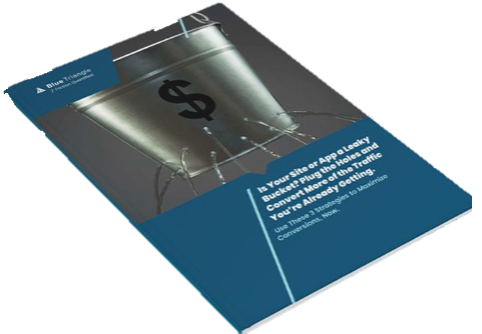How to Use Experience Design to Achieve an Elevated Website Design in 7 Steps
You’ve likely heard the phrase “function over form” when it comes to website design, right? Does this mean that beauty doesn’t matter and that achieving a frictionless experience — i.e. a well-oiled user experience — is everything?
After all, some of the most successful websites on the planet are among the least visually appealing. Think Amazon, Craig’s List, and Goodreads.
It's a topic Nick and I discussed with guest Catherine Gignac, Director Digital Design Experience at American Eagle Outfitters, on a recent episode of The Frictionless Experience.
“People continue to read or to use Goodreads and everyone loves Goodreads, but the internet is always making fun of how ugly the Goodreads app is,” Catherine notes.
“There are outliers out there. Not everything is aesthetically beautiful, but I think that in a lot of cases, it does matter. I think a lot more people would use Goodreads if someone redesigned it.”
Which begs the question: Do website visitors really care about how the site looks?
The research says it does. A study by ResearchGate found that 94 percent of visitors’ first impressions were design-related, with a visually appealing website signaling professionalism and attention to detail.
And in a study by Stanford University, 75 percent of users admit to making judgments about a company’s credibility based on its website design.
Experience Design: What It Is and Why It Matters
Catherine also expresses her belief that how the site looks matters to customers of a lifestyle brand, like American Eagle.
“The secret sauce to working in a digital design space in a lifestyle brand, a brand that's slightly a different nut to crack than an Amazon or a big box digital store, is that you've got that brand element,” she explains.
“There's nothing on AE.com, not one word or one pixel, that we don't consider branded. So everything in and of itself is branded.”
Catherine’s team at American Eagle is responsible for Experience Design, and they shoot for achieving what she terms an “elevated design” in everything they do. She identifies three key aspects to master to be successful in Experience Design:
- Brand DNA. Catherine explains, “You have to be a good UX/UI designer, that's obvious, but you have to understand the brand DNA — what is on brand and what's not; what's considered elevated within that brand space and what's not.”
- Business Case. For any company that has revenue goals and expectations from their digital properties, there has to be a solid business case for making improvement as well. “How do you define the word ‘elevate’ to someone who isn't a creative, who isn't on the brand side, and get them to buy into that word and that importance behind elevating? And then also being able to understand as a designer, the business need, the business case?” asks Catherine.
- User Experience. And of course, improvements need to enhance the user’s experience on your digital properties. Catherine applies a holistic approach that analyzes the user’s complete journey and all of the various ways friction can be added or removed.
“You have to be a good UX/UI designer, that's obvious, but you have to understand the brand DNA — what is on brand and what's not; what's considered elevated within that brand space and what's not.”
How to Build Elevated Digital Experiences
With 14 years’ experience at American Eagle and implementing processes that impact hundreds of people across the UX, Product, DevOps and business teams, Catherine has learned how to successfully build elevated digital experiences that drive business outcomes.
She provides seven tips for creating an experience design culture to deliver elevated digital experiences.
#1 — Understand Your Demographics. It’s critical to know the demographics of your digital audience, and then design to their needs. “We've got a core demographic, but we also have a very, very large population that you can't categorize into one persona or even 10 personas. And we need to design for them all,” Catherine advises.
A key aspect is gathering the insights from your audience about the friction that’s preventing them from completing purchases. Her organization partners with the site architecture team to understand where friction lies, and how to create frictionless experiences using an approach she compares to an archeological dig.
“The architecture team goes and finds, hey, what are our friction points? They look at our internal tools. They look at our voice of the customer inputs. They look at third-party competitors,” with the goal of identifying where they should focus their efforts, Catherine explains.
“What should we be chasing after? What do we have in our own house that is ‘frictiony’ or problematic?”
 #2 — Build an A/B Testing Culture. It’s critical that organizations build a culture that is willing to test everything, which may mean running dozens of simultaneous A/B tests at any given time. Testing not only removes personal biases of the team but also prevents tackling changes that aren’t going to matter.
#2 — Build an A/B Testing Culture. It’s critical that organizations build a culture that is willing to test everything, which may mean running dozens of simultaneous A/B tests at any given time. Testing not only removes personal biases of the team but also prevents tackling changes that aren’t going to matter.
Catherine explains that while they start with their hunches of what will work, they also have to see the data since sometimes what consumers say doesn’t match how they behave.
“Half the time they'll say one thing — ‘I like it when you guys show us this,’ — but then their money will actually show the opposite,” Catherine notes. Which is why it's critical to conduct both quantitative and qualitative testing.
Developing a culture of testing leads to a culture of continuous optimization, always creating better digital experiences for your users.
“When you bring A/B testing in, you're going to optimize every feature you design by testing a few different variations of it, and, in turn, you automatically optimize.”
#3 — Tie Friction to the Business Metrics That Matter. In the end, for most businesses and especially retailers, you need proof that your efforts have actually elevated the digital experience evidenced by improved business metrics, like Revenue per Visitor (RPV). Leadership will want to invest in removing the friction that’s hurting conversions and costing revenue.
“We find is that those two things go hand in hand,” Catherine notes.
“When we create a more seamless experience, when we remove friction points, usually that makes it easier for the customer to shop. And so we like to really tie those ideas together.”
Which often involves storytelling. What’s the story that will convince the organization that removing friction will result in an increase in revenue?
"I think the answer at the end of the day is A/B testing,” Catherine notes. “You can get everyone really emotionally excited about a big bang project and there's a win for the brand team and there's a win for the digital team and there's a win for the customer and you're like, ‘No brainer, everyone's in, this is great!’”
#4 — Use Data to Understand Where Friction in the Customer Journey Lies. Catherine recommends using digital experience analytics tools that provide insight into the customers’ journeys and where they are struggling to continue their journey. Stakeholders like having the ability to watch user sessions, to see where people are scrolling or where they’re having trouble due to friction.
“I love having a tool like that at our disposal because it solves a lot of those assumption conversations that waste a lot of time,” Catherine says.
In our interview, she gives an example of a situation where teams disagreed about how important a specific button on the page was, and testing showed that 70 percent of visitors were scrolling down and clicking on that button.
Having the data “helps reframe internal storytelling, shorten internal storytelling, and help us make decisions a lot faster,” Catherine notes.
#5 — Test Big Ideas as Well as Incremental Ideas. Catherine explains that while they are often testing incremental improvements, they also like to test some out-of-the box ideas that might break normal conventions.
“There are always new and interesting ways to look at core shopping modalities,” Catherine notes.
“And so I think there are two paths when we're looking at frictionless experiences. Like, ‘let's not reinvent the wheel’ is one path. How do we make what we already have better? How do we modernize it?" she adds.
“Then sometimes we have fun, and we go like a completely different path and we say, what's blue sky, what's a big radical idea over here, something that we might want to try? And a lot of times we'll end up in the middle.”
#6 — Be a Team Builder. “Successful designers are actually going to be better relationship builders, first and foremost, than they are going to be designers,” Catherine notes. She notes that when you implement new pages, new features, and new designs, emotions can run high.
“When you show this in art review and you wonder where all the feedback's coming from and everyone feels emotional and passionate, it's because you are literally the first person who's ever taken the work of all these dozens of people — the copywriters, the photographers, the site merchants, the people who designed the clothing,” Catherine explains.
“You're the first person who's actually putting all those pieces together in the first comp of what they will actually see when it hits the site. And so you're not just designing a thing, you're actually building a puzzle.”
“Successful designers are actually going to be better relationship builders, first and foremost, than they are going to be designers.”
Catherine believes that being a good team builder and helping all of the various teams involved in digital experiences is critical to their success. “Your relationship building will get you much further than your design skills. And that probably is most important in finding mutual respect. If you're a product person, respect the designer's craft and vice versa and understand each other's craft.”
#7 — Build the Most Realistic Prototypes Possible. Catherine cautions that when you are building designs in tools like Figma or flat artboards, it doesn’t accurately represent what the final page will look like or how users will interact with the experience.
“Get in the habit, or get your design partners in the habit, of sending you a prototype to your phone that you can click,” she advises. “You're going to feel a lot better.”
Catherine advises using tools that will allow you to show a new design on the actual device and that is clickable as a prototype. “I love to have reviews of my team where I'm like actually looking at what they're showing me like this, instead of on a phone screen embedded in my laptop screen embedded in their Webex shared screen on their screen.”
The bottom line, Catherine says:
"Make it as real as you possibly can when you're going through your final design reviews; you catch the smallest things."
And in the end, it’s the small things that matter when it comes to experience design.
Be sure to check out the full interview on The Frictionless Experience or find it on your favorite podcast app.

During the holiday rush, every shopper matters
Optimize the customer journey before the eCommerce event of the year.

.jpg)


